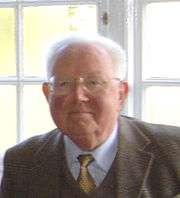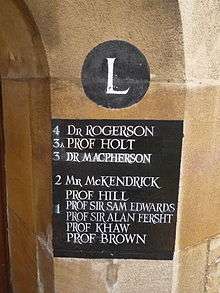Sam Edwards (physicist)
| Samuel Frederick Edwards | |
|---|---|
 | |
| Born |
1 February 1928 Swansea |
| Died |
7 May 2015 (aged 87) Cambridge, England |
| Nationality | British |
| Fields | physics |
| Institutions | University of Cambridge |
| Alma mater |
University of Cambridge Harvard University |
| Doctoral advisor | Julian Schwinger |
| Doctoral students |
Elliott H. Lieb Monica Olvera de la Cruz Michael Cates Nigel Goldenfeld |
| Known for |
path integral formulation polymer physics spin glass granular material |
| Notable awards |
Maxwell Medal and Prize (1974) Davy Medal (1984) Boltzmann medal (1995) Royal Medal (2001) Dirac Medal (2005) |
Sir Samuel Frederick Edwards FLSW FRS (1 February 1928 – 7 May 2015), "universally known as 'Sam',"[1] was a Welsh physicist.
Early life and studies
Sir Samuel was born on 1 February 1928 in Swansea, the son of Richard and Mary Jane Edwards.
He was educated at the Bishop Gore School in Swansea, and Gonville and Caius College, University of Cambridge, the University of Manchester in Britain, and at Harvard University, in the United States. He wrote his thesis under Julian Schwinger on the structure of the electron, and subsequently developed the functional integral form of field theory.
Academic research

Edwards' work in condensed matter physics started in 1958 with a paper[pubs 1] which showed that statistical properties of disordered systems (glasses, gels etc.) could be described by the Feynman diagram and path integral methods invented in quantum field theory. During the following 35 years Edwards worked in the theoretical study of complex materials, such as polymers, gels, colloids and similar systems. His seminal paper[pubs 2] came in 1965 which "in one stroke founded the modern quantitative understanding of polymer matter."[1] Pierre-Gilles de Gennes notably extended Edwards' 1965 seminal work, ultimately leading to de Gennes' 1991 Nobel Prize in Physics.[1]
The Doi-Edwards theory of polymer melt viscoelasticity originated from an initial publication of Edwards in 1967[pubs 3], was expanded upon by de Gennes in 1971, and was subsequently formalized through a series of publications between Edwards and Masao Doi in the late 1970s.[1]
Administrative activities and professional recognition
He was Chairman of the Science Research Council 1973-1977 and between 1984-1995 was Cavendish Professor of Physics at Cambridge University. He was a member of the Board of Sponsors of The Bulletin of the Atomic Scientists and Past President of Cambridge Society for the Application of Research.
Edwards was knighted in 1975. Awards presented to him include the Davy Medal (1984) and the Royal Medal (2001) of the Royal Society, the Boltzmann medal of the International Union of Pure and Applied Physics (1995),[2] and the Dirac Medal of the International Centre for Theoretical Physics (2005). He was also a Founding Fellow of the Learned Society of Wales and he held an honorary degree (Doctor of Science) from the University of Bath (1978).
Personal life
In 1953 Sir Sam married Merriell E.M. Bland, with whom he had three daughters and a son.
His relaxations were gardening and chamber music.
Sir Samuel died in Cambridge on 7 May 2015.[1][3]
Publications
- ↑ Edwards, S.F. (1958). "A new method for the evaluation of electric conductivity in metals" (PDF). Philosophical Magazine. 3 (33): 1020–31. Bibcode:1958PMag....3.1020E. doi:10.1080/14786435808243244.
- ↑ Edwards, S.F. "The statistical mechanics of polymers with excluded volume". Proceedings of the Physical Society. 85 (4). (subscription required (help)).
- ↑ Edwards, S.F. "The statistical mechanics of polymerized material". Proceedings of the Physical Society. 92 (1): 9–16. doi:10.1088/0370-1328/92/1/303. (subscription required (help)).
References
- 1 2 3 4 5 Goldenfeld, Nigel (23 December 2015). "Samuel Frederick Edwards: Founder of modern polymer and soft matter theory". Proceedings of the National Academy of Sciences of the United States of America. 113 (1): 10–11. doi:10.1073/pnas.1523001113. PMC 4711878
 . PMID 26699498.
. PMID 26699498. - ↑ Samuel Edwards: Boltzmann Medallist 1995, IUPAP Commission on Statistical Physics, retrieved 2013-02-20
- ↑ "Obituary Notice" (6388). Cambridge University Reporter. 28 May 2015. Retrieved 9 June 2015.
Further reading
- Paul M. Goldbart and Nigel Goldenfeld, David Sherrington (eds.) (2004). Stealing the gold: a celebration of the pioneering physics of Sam Edwards. Oxford: OUP. ISBN 0-19-852853-1.
- Sherwood, Martin (22 November 1973). "A man for difficult problems". New Scientist. 60 (873): 538–9. Retrieved 2016-07-11 – via Google Books.
Professor Sam Edwards, who recently became chairman of the Science Research Council, describes himself as someone who has always had a taste for difficult problems. Recently, he talked to Martin Sherwood about some of the problems he has tackled in chemistry and physics, and some of those he will now have to tackle as a full-time administrator.
External links
 Media related to Sam Edwards (physicist) at Wikimedia Commons
Media related to Sam Edwards (physicist) at Wikimedia Commons